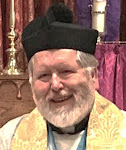In contrast to the conviction at the heart of the Catholic Faith that grace perfects - not destroys - nature, much liberal theology is actually very gnostic in its dealing with the incarnation of Jesus. Anglican liberals still like to claim that they are “incarnational.” This is curious when at the most basic level there is among them a kind of snobbish discomfort, born of “enlightenment” assumptions about the universe, with the idea that matter should really have anything to do with spirit, that God could literally become man in the flesh of Jesus taken from Our Lady, and that “salvation history” could coalesce with real history.
When we consider their watered down ideas about Jesus rising from the dead (i.e. it was "just spiritual"), we want to ask them, “What is it that makes matter so unworthy that it cannot participate in the resurrection?”
We look forward to the restoration and transformation of the entire creation. In Scripture, God’s creation of heaven and earth - all things visible (material) and invisible (spiritual) - is seen to be integral to the ongoing expression of his life and love. In Jesus, the unseen and the seen, spirit and matter, God and Man, are forever joined. The resurrection of the flesh of Jesus is the first stage of the transfiguration and glorification of the entire universe.
St Paul:
“For the creation waits with eager longing for the revealing of the sons of God . . . because the creation itself will be set free from its bondage to decay and obtain the glorious liberty of the children of God.” (Romans 8:19-21)
Raymond Brown (1928–1998):
In our anticipation of God’s ultimate plan, one of two models is usually followed: the model of eventual destruction and new creation, or the model of transformation. Will the material world pass away all be made new, or will somehow the world be transformed and changed into the city of God? The model that the Christian chooses will have an effect on his attitude toward the world and toward the corporeal. What will be destroyed can have only a passing value; what is to be transformed retains its importance. Is the body a shell that one sheds, or is it an intrinsic part of the personality that will forever identify a person? If Jesus, body corrupted in the tomb so that his victory over death did not include bodily resurrection, then the model of destruction and new creation is indicated. If Jesus rose bodily from the dead, then the Christian model should be one of transformation. The problem of the bodily resurrection is not just an example of Christian curiosity; it is related to a major theme in theology: God’s ultimate purpose in creating. (The Virginal Conception and Bodily Resurrection of Jesus, p. 128-129)
Roy Fellows (1931-2006):
Easter reminds us that the Good News is Jesus and the Resurrection. We are not concerned with some vague belief in the immortality of the soul, but with the startling fact of the Resurrection of the body, that is, the whole person. We believe in a new creation of which the Risen Christ is the first instalment. Our God is the one who gives us a share and a promise of this new creation through sacramental signs which use matter - water, bread and wine and the touch of a human hand. There is no room in our Easter faith for a false spirituality which despises the material world. We who worship the Word made Flesh, the Son of Mary, must be concerned for the whole of life and human society in its God-given environment. (The Walsingham Review . . . 1990?)
Gerald O’Collins (b. 1931):
‘Reconciling all things’ (Colossians 1:20), ‘gathering up all things’ (Ephesians 1:10), or ‘making all things new’ (Revelation 1:5) puts the resurrection and redemption in a cosmic context. The resurrection of Christ had not happened without, and certainly not against, creation. It brought a new world in which not only human beings but also all living creatures and the Earth itself would share. (Believing in the Resurrection – The Meaning and Promise of the Risen Jesus, pp. 119-120)
Eric Mascall (1905-1993):
Because there still appear to be people who, after nearly a century of relativity and quantum theory, think of the material world as composed of indestructible ultramicroscopic billiard-balls controlled by fixed unutterable laws, it may be well to recall that modern physics views the world as a spatiotemporal manifold of centres of energy and spontaneity; in such a world Jesus’ resurrection may well be seen, not as a violation or an overriding of the inherent and proper workings of nature, but rather as their joyful and blessed fulfilment, in bringing nature to a perfection that it could not reach by its own efforts.” (Jesus: Who He Is and How We Know Him)


















0 comments:
Post a Comment